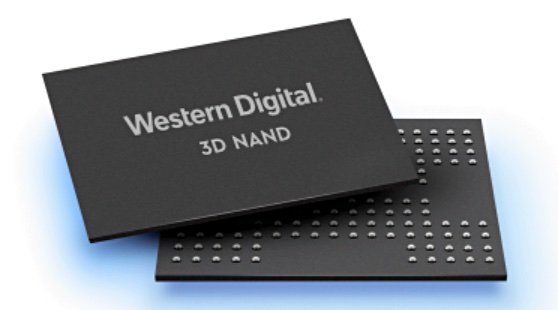Western Digital and Kioxia have crossed the 3-digit layer count barrier, announcing 112-layer 3D NAND, with early shipping dates pegged at Q4 2020.
Their BiCS5 generation and succeeds their 96-layer BiCS4 technology. BiCS stands for Bit Cost Scaling and refers to the lower cost/bit with each succeeding generation. BiCS5 technology will be used to build TLC (3bits/cell) and QLC (4bits/cell) NAND. Dies will be available in a range of capacities, including 512Gb (64GB and TLC), 1Tb (128GB and TLC) and 1.33Tb (1,000,000,000,000 bits and QLC).
The layer count increase, from 96 to 112, means 16 per cent more capacity on that count alone. But WD says second-generation multi-tier memory hole technology, improved engineering processes and other cell enhancements increase BiCS5’s cell array density horizontally across the wafer. That results in up to 40 per cent more bits of storage capacity per wafer than 96-layer BiCS4.
Kioxia says cell array density has risen by approximately 20 per cent over the 96-layer product.
Western Digital also claims design enhancements enable BiCS5 to offer up to 50 per cent faster I/O performance compared to BiCS4. This is in toggle mode for select applications. Kioxia says BiCS5 has lower read and write latencies than BiCS4. Great: we should get both fatter and faster SSDs.

Kioxia plans to start shipping 512Gbit TLC samples in the first quarter of 2020. Volume BiCS5 production should start in the second half of the year.
We might expect BiCS5-based SSDs to be announced then as well, with Q4 being the earliest ship date. Product will be manufactured at Kioxia and Western Digital’s Yokkaichi Plant and their newly built Kitakami plant, both in Japan.
Layered generations
A table of 3D NAND suppliers and their layer generations shows that they have started diverging layer counts from 48 layers onwards, with SK Hynix introducing its 72-layer V4 generation whole the others settled on 64 layers. It rejoined the fold at 96 layers only for Samsung to say it had a 9x-layer count, not 96.

Now, at the 1xx level, sk Hynix has 128, WD/Kioxia have 112, Micron 128 while Intel has gone gangbusters and settled on 144. Blocks & Files expects more layer count divergence in the future.







